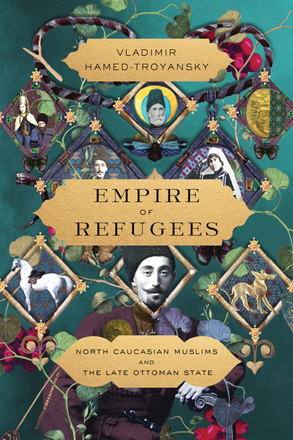You are here
From Refugees to Founders: studying legacy of Circassians, Chechens in Jordan’s history
By Saeb Rawashdeh - May 20,2024 - Last updated at May 20,2024

Circassian ox cart in 1900-1920 in Transjordan (Photo courtesy of Vladimir Hamed-Troyansky)
AMMAN — After the military campaigns of tsarist Russia in 1863–64, which resulted in the ethnic cleansing of Circassians and the displacement of many Muslim communities from the North Caucasus, some of them settled down in the Ottoman Transjordan where they formed a significant minority. Circassians and Chechens arrived in the Balqaʾ region in the late 19th and early 20th centuries.
The Jordan Times spoke with Vladimir Hamed-Troyansky about the history of the North Caucasian diaspora, drawing on his new book, “Empire of Refugees: North Caucasian Muslims and the Late Ottoman State,” published by Stanford University Press in February 2024.
Circassians founded Amman (1878), Wadi Al Sir (1880), Jerash (1884), Naur (1901) and Russeifa (1904) while Chechens established Zarqa (1902), Sukhna (1905) and Sweileh (1906), noted Hamed-Troyansky. “Later, Chechens from Zarqaʾ and Sweileh settled in Azraq (1932). The earliest groups of Circassians included ‘double refugees’, who were violently displaced from the Caucasus by the Russian military in the early 1860’s and from the Balkans in 1877–78. Later Circassian immigrants relocated from refugee villages in Ottoman Anatolia, while many Kabardians [eastern Circassians] and Chechens came directly from the Caucasus in the early twentieth century,” Hamed-Troyansky elaborated.
By the outbreak of World War I, the Circassian population likely exceeded 5,000 people, and the Chechen population was around 1,000 people, Hamed-Troyansky said.
Hamed-Troyansky is a historian of migration in the Ottoman Empire and the Middle East and a faculty member at the University of California, Santa Barbara. He received a PhD in History from Stanford University and served as a postdoctoral scholar at Columbia University.
His book is based on extensive research in over 20 archives in 10 countries, including Jordan. Hamed-Troyansky studied archival evidence in Arabic, Ottoman Turkish, Russian, and Bulgarian. “In Amman, I worked with Sharia court records preserved at the University of Jordan, as well as Ottoman land records held at the Department of Land and Survey. I also interviewed descendants of Circassian and Chechen refugees in Amman, Zarqa, Naur, Sweileh, and Wadi Al Sir,” he elaborated, adding that he consulted rare letters written by North Caucasian refugees and preserved by their descendants in private collections.
“These unique documents allowed me to reconstruct the making of Amman as a Circassian refugee village between 1878 and 1914 and to tell stories of individual refugees: for example, Sayetkhan, a Circassian woman who at one point was the richest resident in Ottoman Amman, and her Circassian attorney, Jawad Khutat, whose family searched for a perfect location throughout Anatolia and the Levant before finding one in Amman,” Hamed-Troyansky underlined.
Regarding the integration of Caucasian Muslims into Jordanian society, he continued: “Ottoman Transjordan, or more specifically the Balqaʾ region, was the southernmost area of refugee resettlement in the Ottoman Empire. Overall, North Caucasian refugees established over a thousand refugee villages throughout Anatolia, the Levant and Iraq,” Hamed-Troyansky said, adding that Circassian and Chechen refugees established three of the four largest cities in Jordan: Amman, Zarqaʾ and Russeifa.
“Two factors distinguish the North Caucasian refugee settlement in Ottoman Transjordan from that in the rest of the empire. First, the Hejaz Railway, which connected Amman to Damascus in 1903 and to Medina in 1908, boosted the economy of the region. Syrian and Palestinian investment arrived with the railway, transforming Amman from a Circassian refugee village into an Ottoman boomtown. The economic and political significance of Amman increased because of the railway,” Hamed-Troyansky explained.
Second, Circassian and Chechen refugees made strategic alliances with Bedouin communities and the early success of Amman owes to the strong alliance between Circassians and the Bani Sakhr, dating to the late 1890s, the scholar said.
“The Bani Sakhr-Circassian alliance stood the test of time, as the Bani Sakhr mediated between Circassians and the Balqawiyya communities in 1910 and maintained robust economic ties into the Emirate era. That alliance defined the politics in the Balqaʾ region in the early twentieth century, facilitating the rise of Amman,” Hamed-Troyansky highlighted.
Circassians and Chechens are part of the fabric of Jordanian society: “Because they lived in Jordan for generations, Arabic is the dominant language for these communities, although many families also retain their ancestral languages,” Hamed-Troyansky noted, adding that Circassians and Chechens made significant contributions to Jordan’s commerce and military, as well as administration and arts, over the years.
Jordan’s House of Representatives has three seats allocated for Circassians and Chechens, and Jordanian governments have traditionally had a minister of North Caucasian origin, he explained. “This degree of political representation and pluralism is remarkable and reflects a laudable commitment to the diversity of Jordan’s citizenry. The history of Jordan as a safe haven for refugees deserves to be celebrated and upheld,” Hamed-Troyansky concluded.
Related Articles
AMMAN — In the middle of the 19th century, the northern Caucasus was a battlefield between the Russian and the Ottoman empires.
Istanbul: Journal of Caucasian Studies (JOCAS), September 2015-March 2017The Journal of Caucasian Studies (JOCAS) is a peer-reviewed, bi-ann
AMMAN — The Great Arab Revolt is the cornerstone of Jordan’s political legitimacy, according to an Oxford University professor.During a


















